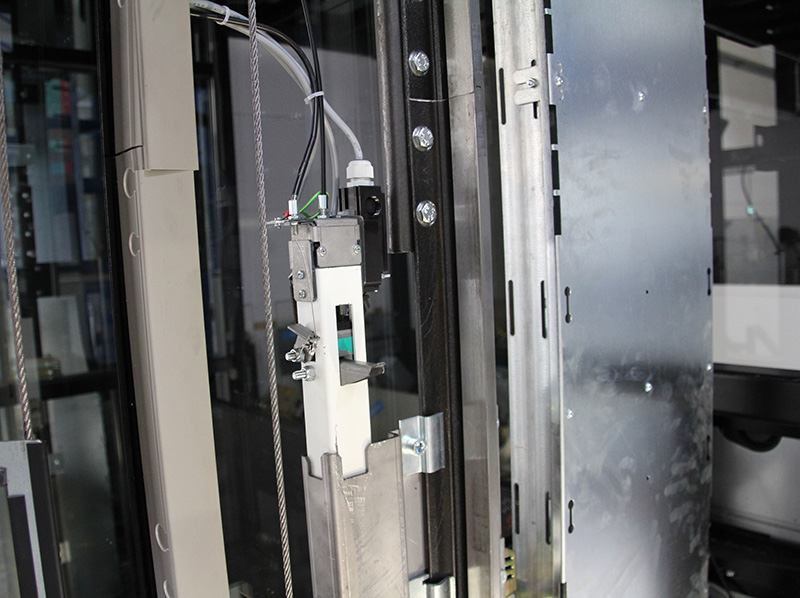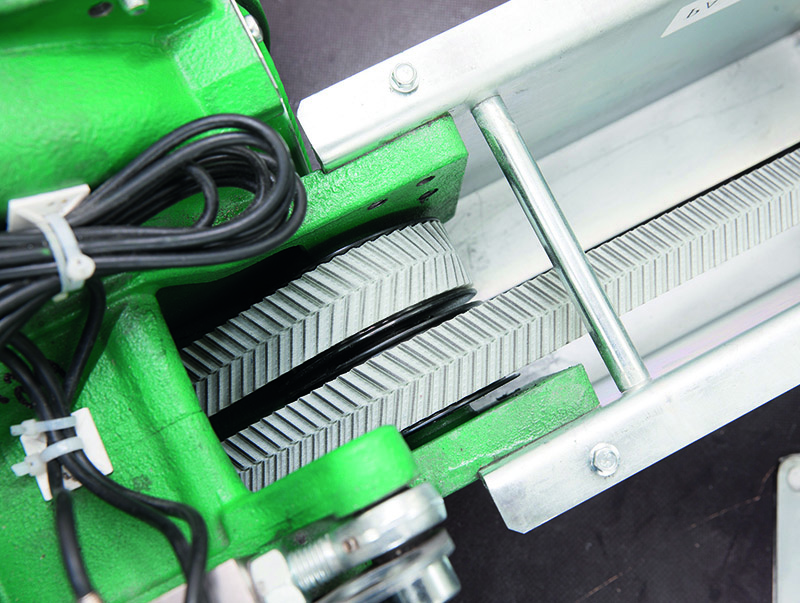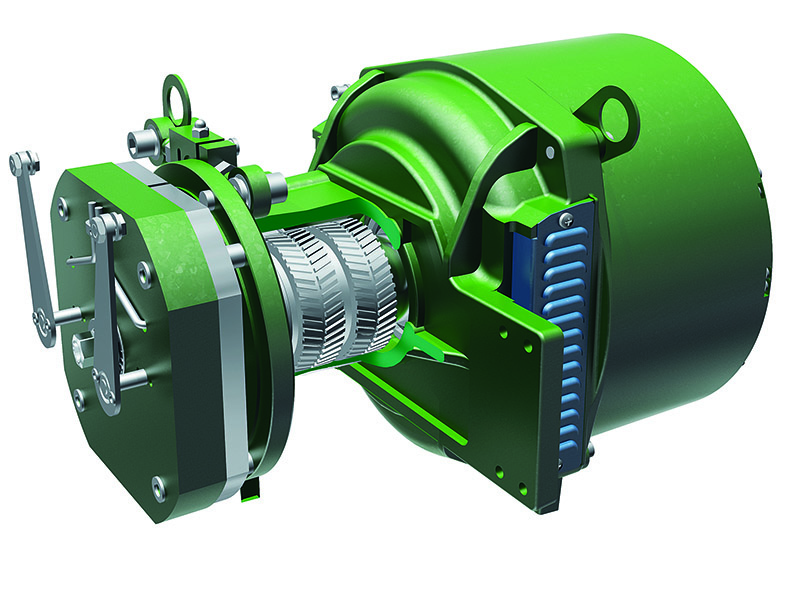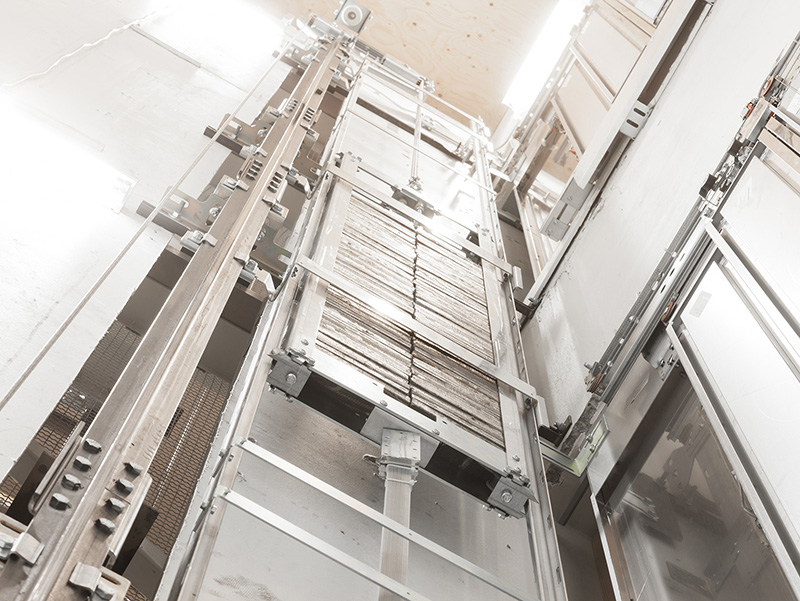Space and energy-efficient complete replacement
Kone has developed an innovative product for the complete replacement of existing lifts in the form of the NanoSpace: space-efficient, energy-saving and capable of installation in next to no time together with a completely new drive and suspension concept. The lift has been available on the German market since 1 June 2014. The first lifts are now in operation.
The new lift type was designed especially for the modernisation or complete replacement of lifts. The requirements for the new product were the following: especially quiet operation, because older shafts were often not built as solidly as today and/or are adjacent to rooms requiring insulation, such as bedrooms; machine-rooms can also be found next to residential spaces. An option for rapid installation and optimal exploitation of the shafts, which tend to be quite small and as a result preclude barrier-free cars, was also desired.
This led to the development of the NanoSpace, unveiled at the beginning of 2014. Its key data: Vmax 1.0 m/s, nominal load 240-630 kg, a maximum of 16 landings, max. conveyance height 40 m. The lifts can be operated in pairs. Consequently the NanoSpace covers a wide range of lift modernisations in the residential and business building segment. After all, over half of all lifts in Germany are more than 20 years old and technically outdated.
Initial references
The first lifts put into operation in Germany in 2015 are not only faster and more economic than their predecessors, but also have much larger car floor areas. In the Stuttgart Hotel Astro the car floor area grew by 37 per cent from 99 cm width and 80 cm depth to 105 cm and 107 cm. In the residential and business building Bahnhofstraße 13 in Herrenberg the car floor area even increased by 41 per cent to 106 cm x 140 cm.
As a result, this lift can also be used by wheelchair users. Moreover, the Herrenberg lift could be extended to the second floor and as a result made all the floors of the building accessible. However, the NanoSpace is not a conventional lift without machine-room, since the drive is located in the shaft pit.
Innovative drive and suspension concept
When it comes to the NanoSpace, the drive has for the first time in lift technology been separated from the suspension. The hybrid drive system combines car, drive and balancing weight in a closed system. The car drive is provided by two cogged belts.
The car is held on each side by three steel ropes. These ropes run at the top from the car via deflection sheaves in the shaft head to the two balancing weights on the shaft sides. A cogged belt is attached to the lower side of each of the weights, which then runs via deflection sheaves into the shaft pit and to the motor on the underside of the car and ends there in a tensioner.
Travel movement always occurs via traction: on the lift car for the upward travel, on the balancing weights for the downward journey. Since the belts are supported during the movement of the car by the ropes – the belts do not hold the car, they only move it - the load on the former sinks, boosting their service life. The balancing weights of the NanoSpace are unnecessary for the traction: this is ensured by the interlocking of the cogged belts and traction sheave on the drive.
Space-saving design
Compared to standard lifts, the NanoSpace not only has a counterweight, but also two relatively slender balancing weights on each side of the car. This creates space for larger cars in the shaft. The rule of thumb is shaft width minus 2 x 150 mm = NanoSpace car. The 2 x 150 mm are needed for the balancing weights, rails and mounting.
Less shaft width is also required as a result of the now four- instead of two-leaf landing doors and on account of the drive, which is not located on the side in the shaft head, but in the pit instead. The control technology is in the switch cabinet in the area of the lowest stop. The result is a car that is mathematically up to 50 per cent bigger.
Safety systems
With the regard to the European standard EN 81-20 that will alone be valid from September 2017, a safety system was developed, which can guarantee the protective space of 2,000 mm irrespective of the at least 800 mm deep pit. If the technician opens the shaft door using the triangular lift door release key, a safety bolt folds out close to the guide rails, which in the event of an emergency triggers the catch device.
Proven technology was used to secure the protective area in the shaft head: manually erectable contact-protected safety supports. This produces a minimum shaft head height of 2,900 mm.
Drive, noise insulation, travel comfort
The NanoSpace drive is frequency controlled, permanently excited and as a result highly energy efficient. Thanks to its location in the pit, noise in the residential areas adjoining the shaft is kept to a minimum. Disruptions by maintenance work are likewise virtually ruled out.
The form-closed connection of cogged belts and traction sheave at the same time ensures permanent traction, which contributes to gentle arrivals and departures at the landings. The suspension rope was fitted with vibration dampers that prevent rope oscillations and in this way likewise ensure a pleasant journey.
Rapid replacement
The design, components and installation process were conceived not least with an eye on the shortest possible installation process. For example, the position of the motor in the shaft pit renders transport through the shaft to highest landing superfluous.
Instead the drive is suspended below the car and lowered into the pit. The simple rope and drive belt guidance is practical too: the suspension rope and drive belts are suspended in a 1:1 relationship. As a result, the rope length to be installed is reduced along with the number of deflections.
www.kone.de





























Write a comment